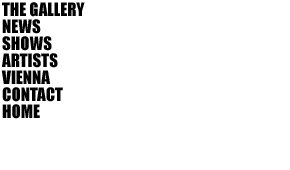
ART BASEL / Art Statements
double-track: Hans Schabus: Zentrale
Size G (Large) gauge tracks have been installed a half meter under the ceiling of Hans Schabus’ studio, roughly made holes in the walls lead them through all the rooms. Somewhere along the way, a red locomotive patiently waits for days, weeks, for an electrical current that will allow it to make its rounds circumscribing the contours of the outer walls. Without limiting it, the space is marked “as the container of everything, where everybody or anyone finds or is able to find (here and there according to the dimensions of the neighboring objects) their being or becoming,” as written by Otto von Guericke (who is highly esteemed by Schabus).
Schabus considers sculpture as the spatial organization of objects that occasionally develop their own will. The film “Der Passagier” (2000), shot with a camera mounted on the back of the locomotive, leads behind shelves and storage spaces through caves, plateaus made of wood, dusty cardboard and forgotten items. What happens here has been withdrawn from reach until the artist looks for an object and either finds or invents a use for it. Thus the material does not necessarily define the method; the function does not adhere to the form. “Zentrale” (2001) shows the bulky elegance that can remain in such neglected and transient objects: right-angled slat remnants, extra blocks whose counterparts have long since become sensible pieces of furniture, boards with footprints and pencil markings are fit together into a light stable wall that nevertheless swings like an irregular baroque church façade. The spatial demarcation of a membrane, mediating inward and outward, claims its own status as object, thus creating little intermediary-worlds that are as present and inapproachable as the remote landscapes of Schabus' studio.
Instead of the niches and angles, a wide dark plateau; instead of the larger than cat size locomotive, a smaller than mouse size double is underway in narrow hallways; instead of the material having its own will, it is strictly disciplined. The “Table” (2001), however, is not a work that contradicts “Zentrale” and the biotope of objects. It is, rather, a different and ironic variant of the sculpturing of space. The table top is as thick as light and under the smooth surface hides an inner life that is as absurd as it is sensible. More tracks are laid under Plexiglas, on a sunken record player there is an album from Schabus (A: "9238m": a trip with the Gailtalbahn, B: "7500 rpm": sounds of a circular saw), and loudspeakers; a bottle of home distilled schnapps next to a schnapps glass and an ashtray. They slowly lift themselves from the depths with the press of a button. At one side of the table are the controls, which offer along with a few megalomaniac fantasies, their sublimation: Dr. No as an intoxicated miniature train conductor. Perfectly crafted, the merry object has its jagged edges in the details; the album is a circular saw made out of vinyl, the little locomotive follows the tracks laid in the studio in miniature and the cheap glass ashtray, which fits precisely into its pedestal, still seems out of place. The table collects and concentrates the biographical elements, sites, needs, instruments and pleasures; essential prerequisites for Hans Schabus’ work, and not his alone. In place of the aesthetics of expression, he makes suggestions that go beyond the usual dimensions: Art and usefulness beyond mere observation still remain contradictions. At most, the label of design is given; in a less flattering tone one speaks of craftsmanship and thinks of bungling plumbers. As a contemplatively protected object, Schabus’ table would collect nothing more than dust and fill up the space rather than create it. It is given justice when it is used; even with a second car behind the locomotive and a new album under the needle arm: the right to changes in the superficiality of daily life. And maybe there is not only schnapps in the bottle, but also a message.
And the clear, smooth control center is also a catastrophe zone, the landing strip of a crashing Hans Schabus. From a not very lovely sky, he falls through screen static and wildly glowing letters, finally thundering onto the table top. The video 'Zentrale' (2001) shows what the artist can and must live through. Suddenly, two Hans Schabus souls are carrying on in the studio: a heinously grinning demon who, unimpressed by the hard blow, takes his place quite naturally at the controls and scares the hell out of the diligent and increasingly unnerved woodworker. Each faces his alter-ego and coexistence seems just as unthinkable as a final showdown. What is thinkable, is the entrance of further identical protagonists. In his reproduction and expressivity through his work, the one body of the artist becomes a room of crisis-like identity. Included in Schabus' exhibit is the statement "Just because I am paranoid does not mean that no one is pursuing me," by Luis Campagna. The footsteps behind could very well be one's own. (Friedrich Tietjen)

